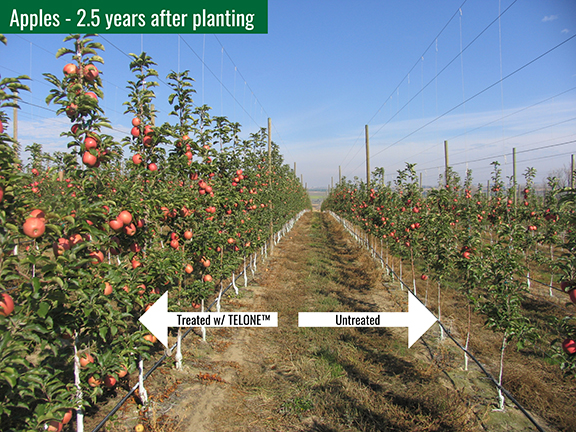Know When It’s Time to Dial up the Nitrogen for Almond Crops
For almond growers, 2022 is shaping up to be another interesting year. As I write this a few weeks before bloom, January looks to be mostly dry, Lake Shasta storage is half of January average, the market is off, and fertilizer costs are way up from a year ago. No one can know for sure what the season will bring, but making the most out of more expensive fertilizer materials is an overall goal worth looking into.
Will it pay off? I think there is a good chance it will. For example, with UN32 currently running around $1.15/pounds N, increasing N fertilizer efficiency (pounds N removed from the orchard in the crop per acre/pounds N applied per acre) from 70% to 80% pencils out to a $35/acre savings (less UN32 needed) for an orchard producing 2500-kernel pounds/acre without impacting tree N status or yield. In addition, running orchard N nutrition closer to adequate vs. excessive could save hundreds of dollars by reducing hull rot incidence.
This is the March edition, so how would an efficient, effective N program look this time of year?
Early March is the start of the nitrogen input season in almond orchards. The 30-day supply of N that trees store overwinter in woody tissue (roots, trunk, and branches) and remobilize to grow new tissue beginning at bloom is exhausted. External N sources, mostly ammonium and nitrate in the root zone soil, become the primary sources for N; the building blocks for continued nut and shoot growth.
SMALL BUT CRITICAL NEED
March-to-mid-April orchard N needs are much less than that for late April into early June, but they are critical to the development of healthy current and future almond crops. This is because 80% of almonds on a tree grow on spurs. Spurs in a tree die at a rate of 5% to 25% annually, so vegetative growth (new extension shoots and short spurs on last year’s shoots) is needed to deliver a replacement “crop” of spurs for future production.
Spurs grow in the spring, usually stopping extension growth by April or early May. Adequate N availability in March feeds both current year crop and shoots/spurs where future crops will grow. Click here to learn more about vegetative growth in almond.
How much N is needed to meet orchard N demands in March? The current recommendations can be found in the free publication, Nitrogen Best Management Practices (BMP), available from the Almond Board of California. The total crop N need is still the same as it has been for the last decade — 68 pounds N/1000 kernel crop. Therefore, a 2500-kernel/pound crop will contain 170 pounds N, and that much N will leave the orchard at harvest.
The research-based recommendation is for 20% of the total annual N budget of an orchard to be available at the root surface between 70% leaf out (so applications should start just before this) and the time nuts reach full size. This timing is roughly the middle of March to mid or late April. The estimated crop yield and fertilizer N inputs in March-April should be based on crop yield estimated from orchard history and bloom conditions. In the new Nitrogen BMP publication, 30 to 40 pounds N/acre/year is recommended to support vegetative growth in trees sixth leaf or older. How much of that should go into the March-April applications? The amount is for growers and CCAs to decide, but my guess is at least 10 pounds N/acre followed by that rate or more in April.
What is the source of March-April N inputs in almond orchards? Generally, it is fertilizer N. Soils are generally cool in March/April vs. May or summer so there is relatively less N available through mineralization of soil organic matter. Ground water used in irrigation can contain nitrate nitrogen; however little irrigation water is usually applied early in the season (March-April) so the N added this way can be, generally, much less than that added later in the season. That leaves fertilizer N.
The most efficient N fertilizer program delivers multiple, small amounts of N as compared to a single application in March. There has been a widespread adoption of this strategy in California. At a statewide meeting in fall of 2020, more than 30% of the audience of growers or CCAs reported applied low rates of fertilizer with every irrigation. These small “shots” of N add up to a very efficient “spoon feeding” fertilizer program, especially if the N is injected in the second half of the irrigation set so that the fertilizer stays in the upper rootzone where the largest number of active roots are found.
LEAF SAMPLING TIME
Finally, to ground check the March-April N program described above, take an early season leaf sample. This sample protocol and timing was developed at UC Davis to accurately predict orchard leaf N levels in summer from a mid-April sample. Since the July leaf sample is too late to change a fertilizer program for the current season, April sample results, predicting summer leaf levels, should be helpful in adjusting a fertilizer program to keep leaf levels adequate — not too much nor too little. If the prediction is for high summer N levels, the subsequent fertilizer N rates should be reduced, while the opposite is true if leaf N prediction is for lower than desired summer leaf N levels. For details of the spring leaf sampling as well as general N rates and timings for the remainder of the year, click here to check out the Almond BMP publication.
Best of luck to all growers in the new year. I hope the information in this column will be helpful in beginning to chart a course through the coming season.










